
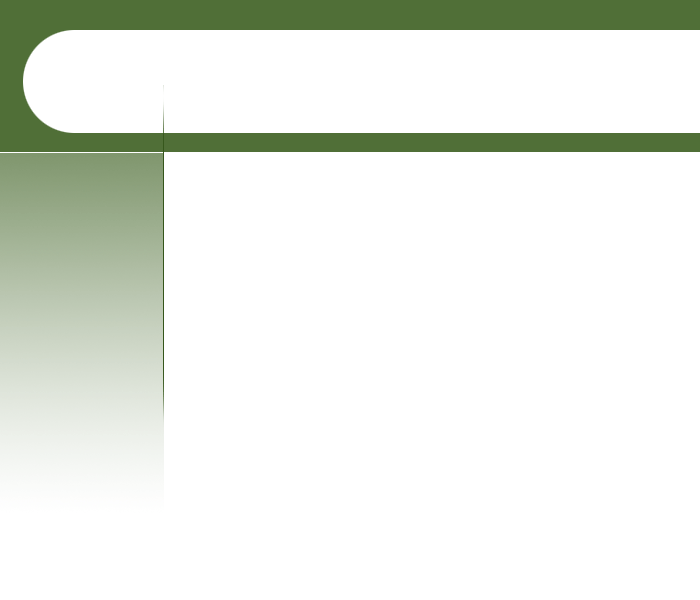



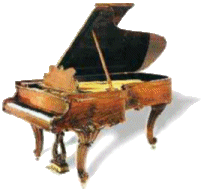

Our Services

For contact information, go to the "Home Page"

Appointment Times--Call us for tunings, minor repairs, and regulation work, and we will schedule an appointment to service your piano within two weeks. Our usual appointment times are Tuesdays, Wednesdays, and Thursdays at 10:00 a.m. or 2:00 p.m. (except during the July-August summer vacation).
Our Service Area--We serve piano owners in locations up to 50 miles from our home/shop, and for an additional fee, we will service pianos further away.
Our Guarantee--We guarantee "full satisfaction or your money back." If you are not fully satisfied with our work, we will either arrange to make additional improvements that will, hopefully, meet your expectations, or we will frankly acknowledge that we are unable to meet your expectations and reimburse any money paid or owing for the work in question.
Payment Terms--Service Contracts up to $1,000: Payment in full upon completion of project. Service Contracts over $1,000: Deposit 50% on pick-up date or commencement of project, balance on date of delivery or project completion. On accounts delinquent over 30 days, we charge 2% monthly on the outstanding balance, calculated on the first day of each month.


Our Privacy Policy--RAY'S PIANO SERVICE collects only information voluntarily sent via email or through direct contact from you. We will not sell or rent this information to anyone. We will use your information to respond to you regarding the reason you contacted us. We will not share your information with any third party other than as necessary to fulfill your request, e.g. to ship an order. Unless you ask us not to, we may contact you in the future to inform you about special offers, new products or services, or changes to this privacy policy. At any time you can ask us to change or delete any information we have about you, or you can opt out of any future contact from us. Don't hesitate to contact us at any time if you have a concern about our use of information about you.
Security--When you submit sensitive information (such as credit card data) to us, that information is protected both online and offline. Sensitive information submitted online is encrypted and transmitted to us in a secure way, and the computers in which we store personally identifiable information are kept in a secure environment. We also protect your information offline. Only employees who require the information to perform a specific job (e.g. billing or customer service) are granted access to personally identifiable information.
Typical Services: An Overview
Scroll down. . .
Scroll down. . .

Tuning and Voicing--Tunings are the "mainstay" of piano maintenance. Once tuned to concert pitch, a piano will retain this pitch only until the next seasonal change in climate when the wood parts of the piano expand or contract due to changes in the relative humidity of the piano's environment. Generally, the pitch goes sharp at the beginning of summer because of an increase in the relative humidity of the surrounding air as doors and windows are opened to let in moist outside air, and the pitch tends to go flat at the beginning of winter because of a decrease in the relative humidity of the air as the home is heated. Piano owners who practice for performances or for duets with other instruments are wise to call for "concert quality" tunings at the beginning of each season, while most piano owners are satisfied with an annual tuning. In any case, to ensure optimum tuning stability, tunings should be scheduled during the same season each time they are done.
If you have just purchased a new or reconditioned used piano, you should allow the piano to become acclimatized to your home for at least a month before the first check and tuning. The piano should be tuned at least twice during the first year after being moved to a new location, and thereafter annual tunings are recommended.
The tonal quality of a new piano should be consistent from top to bottom. The expert piano technician can "voice" the hammers of the piano in order to ensure that the tonal quality (loud, soft, brilliant, dull, etc.) of all the notes is consistent. After years of striking piano wires under tension, the striking point of hammers wear to form grooves on the striking surface, causing the tone to become dulled. The wear on the top treble hammers can be so extensive that the felt has worn off completely, resulting in a "clunking" noise as the wood core of the hammers strikes the strings. Also, over time the felt material of hammers tends to soften, resulting in less brilliant tone. To restore the tonal quality of a piano, the piano technician can "reshape" the hammers if enough felt remains, or he can install a replacement set. When appropriate, Ray Klapwyk will recommend improvements in the tonal qualities of your piano.
If you have just purchased a new or reconditioned used piano, you should allow the piano to become acclimatized to your home for at least a month before the first check and tuning. The piano should be tuned at least twice during the first year after being moved to a new location, and thereafter annual tunings are recommended.
The tonal quality of a new piano should be consistent from top to bottom. The expert piano technician can "voice" the hammers of the piano in order to ensure that the tonal quality (loud, soft, brilliant, dull, etc.) of all the notes is consistent. After years of striking piano wires under tension, the striking point of hammers wear to form grooves on the striking surface, causing the tone to become dulled. The wear on the top treble hammers can be so extensive that the felt has worn off completely, resulting in a "clunking" noise as the wood core of the hammers strikes the strings. Also, over time the felt material of hammers tends to soften, resulting in less brilliant tone. To restore the tonal quality of a piano, the piano technician can "reshape" the hammers if enough felt remains, or he can install a replacement set. When appropriate, Ray Klapwyk will recommend improvements in the tonal qualities of your piano.
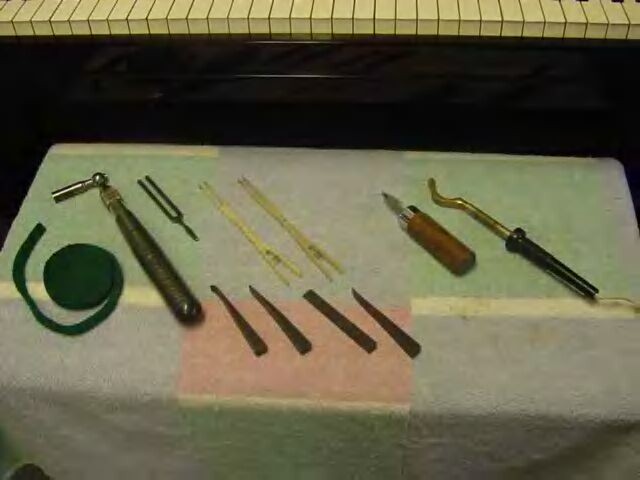
The Tuner's Basic Tools
Left to right:
Temperament strip for muting strings in the middle section which is tuned first.
Tuning hammer, tuning fork for identifying the pitch of the first note tuned
Mutes for silencing the strings not being tuned
Voicing tool for decreasing tone dynamic of individual hammers, hammer iron for increasing tone dynamic.
Left to right:
Temperament strip for muting strings in the middle section which is tuned first.
Tuning hammer, tuning fork for identifying the pitch of the first note tuned
Mutes for silencing the strings not being tuned
Voicing tool for decreasing tone dynamic of individual hammers, hammer iron for increasing tone dynamic.

Repairs, Reconditioning, and Regulating--Although quality pianos are "built to last a lifetime," the "touch" and efficiency of the keyboard changes over time because of the wear of felt, leather, and cloth parts, and because the pressure exerted on "center pins" turning in cloth bushings when the keys are depressed may cause the moving parts to wear unevenly. Additionally, wood parts warp and shrink over time, causing screws to loosen. Consequently, at regular intervals, maintenance adjustments should be made, moving parts should be lubricated, screws should be tightened, and malfunctioning parts should be replaced in order to maintain the piano at peak performance. The cost of these improvements is well worth the investment, because they will result in a longer-lasting, more reliable piano.
Once every 20 years, the expert piano technician should clean the piano interior, remove the piano action for reconditioning, tighten all cabinet screws, and conduct a complete "regulation" of the piano's adjustments. Reconditioning the action might include cleaning and lubricating all parts, reshaping or replacing hammers, installing new bridle tapes (uprights) or knuckles (grands), and tightening all action screws. Regulation adjustments might include correcting the hammer blow distance, reducing "lost motion," spacing and adjusting key height and dip, correcting letoff (uprights), letoff and drop (grands), and adjusting spring tension (grands). If necessary, worn underkey punchings and bolster cloth are replaced at this time, and worn or chipped keytops can be replaced. The cost of action reconditioning and regulating can vary from as little as $300 or as high as $2,000 depending on the work involved and the cost of new parts.
Once every 20 years, the expert piano technician should clean the piano interior, remove the piano action for reconditioning, tighten all cabinet screws, and conduct a complete "regulation" of the piano's adjustments. Reconditioning the action might include cleaning and lubricating all parts, reshaping or replacing hammers, installing new bridle tapes (uprights) or knuckles (grands), and tightening all action screws. Regulation adjustments might include correcting the hammer blow distance, reducing "lost motion," spacing and adjusting key height and dip, correcting letoff (uprights), letoff and drop (grands), and adjusting spring tension (grands). If necessary, worn underkey punchings and bolster cloth are replaced at this time, and worn or chipped keytops can be replaced. The cost of action reconditioning and regulating can vary from as little as $300 or as high as $2,000 depending on the work involved and the cost of new parts.
Reconditioning an Upright Piano: An Illustration (pictures taken in our shop)
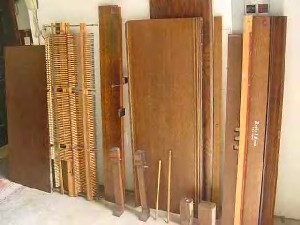
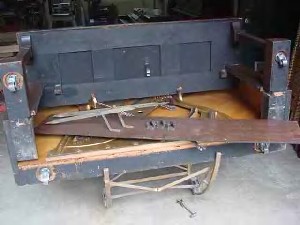
1 - Piano is completely disassembled.
2 - New casters are installed and the pedal board is rebuilt.
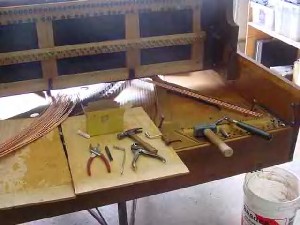
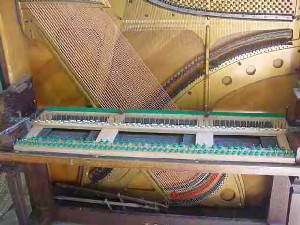
3 - New bass strings are installed.
4 - New underkey punchings are installed.
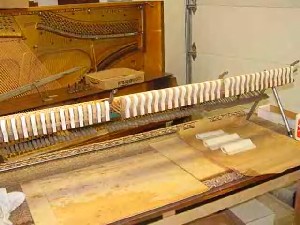
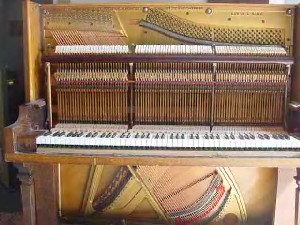
5 - Action Reconditioning--New hammers are installed, all action screws are tightened, new bridle tapes are installed, and all worn and defective action parts are replaced.
6 - Piano is ready for regulation and tuning--Regulation includes setting hammer blow distance and hammer heights and leveling, regulating letoff, dip, dampers, spoons.

Evaluation Report and Service Offer--After over 35 years' experience with many types and brands of pianos, we can give you an idea about whether your piano might have restoration potential. Although we can tell you the age of your piano if you let us know the serial number, we must examine your piano to provide you with an appraisal of its current market value or an estimate of the cost of restoring it. In evaluating a piano, we test items such as:
1 - Tuning pin torque: will they hold pitch? If they are loose, we might recommend repinning with larger pins or installation of a new pinblock.
2 - Condition of the soundboard and bridges: whether there are cracks that can be repaired, or whether there is sufficient downbearing to ensure good tone after restoration.
3 - Condition of the strings: corrosion, rust, remaining tensile strength, etc. If the piano is repinned, new strings are usually recommended as well.
4 - Condition of the action components: hammers, dampers, backchecks, wippens, butt felts, capstans, bushings, etc. If badly worn, these parts should be replaced.
5 - Condition of keytops. If ivories are missing or chipped, we might recommend replacing with new plastic. If black keys are badly worn, we might recommend replacing with plastic or ebony.
6 - Condition of keys and key bushings. If bushings are badly worn, they should be replaced. If they are tight, they should be regulated. Cracked key buttons should be replaced.
7 - Condition of underkey punchings. These should be replaced if worn.
Is the piano well regulated? Adjustments such as hammer blow distance, keydip, letoff, damper movement, etc. must be correct for the piano to play efficiently. Also, re-regulation is required when action parts such as hammers or knuckles are replaced, or when new keytops are installed.
8 - Condition of cabinet and bench. Veneer repair may be required, increasing the potential cost of refinishing.
Condition of lyre and pedal mechanisms. If bushings are badly worn, these should be replaced. Also, if the lyre is loose, it should be securely fastened with new bolts.
For an evaluation fee, we will provide you with a "Report & Service Offer" containing (1) a detailed appraisal report on your piano showing our opinion of its general condition, the cost of replacing it with a new piano of similar type and quality, its "as is" value, and its potential value after it has been restored., and (2) an estimate of the cost of restoration work. Our estimate will include prices for various options, from essential improvements to those which you might wish to include. If you sign a Contract with us to restore your piano, we offer to pick it up and deliver it after improvements are completed. Cost of pick up and delivery depends on your distance from our shop.
1 - Tuning pin torque: will they hold pitch? If they are loose, we might recommend repinning with larger pins or installation of a new pinblock.
2 - Condition of the soundboard and bridges: whether there are cracks that can be repaired, or whether there is sufficient downbearing to ensure good tone after restoration.
3 - Condition of the strings: corrosion, rust, remaining tensile strength, etc. If the piano is repinned, new strings are usually recommended as well.
4 - Condition of the action components: hammers, dampers, backchecks, wippens, butt felts, capstans, bushings, etc. If badly worn, these parts should be replaced.
5 - Condition of keytops. If ivories are missing or chipped, we might recommend replacing with new plastic. If black keys are badly worn, we might recommend replacing with plastic or ebony.
6 - Condition of keys and key bushings. If bushings are badly worn, they should be replaced. If they are tight, they should be regulated. Cracked key buttons should be replaced.
7 - Condition of underkey punchings. These should be replaced if worn.
Is the piano well regulated? Adjustments such as hammer blow distance, keydip, letoff, damper movement, etc. must be correct for the piano to play efficiently. Also, re-regulation is required when action parts such as hammers or knuckles are replaced, or when new keytops are installed.
8 - Condition of cabinet and bench. Veneer repair may be required, increasing the potential cost of refinishing.
Condition of lyre and pedal mechanisms. If bushings are badly worn, these should be replaced. Also, if the lyre is loose, it should be securely fastened with new bolts.
For an evaluation fee, we will provide you with a "Report & Service Offer" containing (1) a detailed appraisal report on your piano showing our opinion of its general condition, the cost of replacing it with a new piano of similar type and quality, its "as is" value, and its potential value after it has been restored., and (2) an estimate of the cost of restoration work. Our estimate will include prices for various options, from essential improvements to those which you might wish to include. If you sign a Contract with us to restore your piano, we offer to pick it up and deliver it after improvements are completed. Cost of pick up and delivery depends on your distance from our shop.















